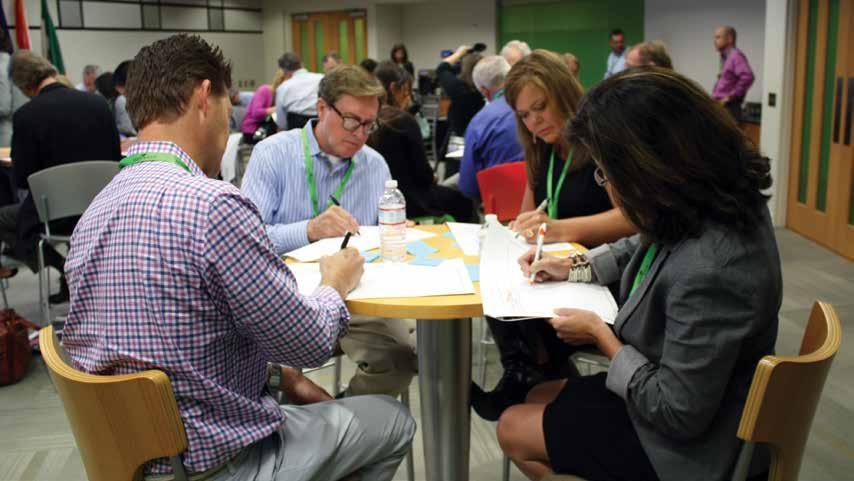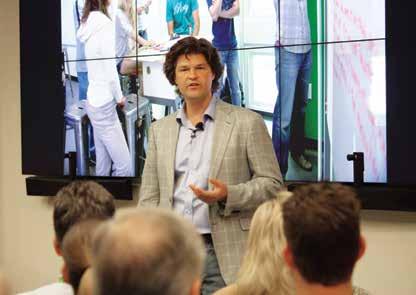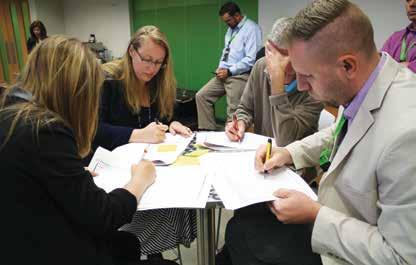
3 minute read
DESIGN THINKING FOCUSES ON END-USER NEEDS
from Raven Issue No. 22
Justin Ferrell is director of fellowships at the d.school at Stanford University, an innovation hub for students and faculty in engineering, medicine, business, law, the humanities, sciences and education. The d.school teaches an approach to innovation that emphasizes connecting with potential end users in empathetic ways, resulting in new products and services that faithfully and creatively address specific needs.
A career journalist specializing in organizational behavior and change, Ferrell served for seven years at The Washington Post where he was director of digital, mobile and new product design. He brought mobile designers and programmers into The Post newsroom and enabled teams of reporters, editors, designers and developers to create groundbreaking work. Ferrell has spoken on creative culture in many venues, ranging from the SXSW Interactive festival in Austin to Education City in Doha, Qatar. He is an alum of the John S. Knight journalism fellowship at Stanford.
Advertisement
Ferrell visited Glen Raven’s Concept Gallery this past spring and in the following interview shares his thoughts on how design thinking can make innovation more successful.
WHAT ARE DESIGN THINKING AND HUMAN-CENTERED DESIGN?
When you create a new product or service and work only from within your own organization, there’s a strong possibility that your new creation will not be what the end user wanted. It’s not what they’ll find useful.
In design thinking and human-centered design, you begin by focusing on a problem or an opportunity that you’ve uncovered by talking with the people you’re designing for. Design thinking requires that you get outside of your comfort zone, outside of your own organization. You go to where the people are that you are creating for, and you really uncover their needs before you even start coming up with an actual product or service.
WHY IS A MULTIDISCIPLINARY APPROACH IMPORTANT TO DESIGN THINKING?

If you hang out only with people all in the same field, you are more likely to come up with incremental ideas because the people in the same disciplines are predisposed to think in the same way. When you get experts together from different fields and teach them how to work together, you are much more likely to uncover ideas that you would not uncover on your own. You encourage everyone to focus their individual expertise on what you’ve discovered about the people they’re designing for. It’s all about how you can create things together that you could not create in your own silo groups.
WHAT ARE THE MAJOR COMPONENTS OF THE DESIGN-THINKING PROCESS?
We teach design thinking in a linear way but it doesn’t have to be a linear process. It starts with empathy – really putting yourself into the shoes of the person you’re designing for. After you develop a deep understanding of your end user, you then define the problem and identify the opportunity.
The next step is to ideate or brainstorm possible solutions and then choose one of these ideas to prototype. You create a prototype to get it into the hands of potential users for feedback. The last step is testing for additional feedback to see if your solution really works. It’s only then that you know if you have something that will be successful in the real world.
HOW DOES DESIGN THINKING AFFECT THE ROLE OF LEADERSHIP?

In a traditional hierarchical model, leaders set up teams, create visions and then attempt to lead those teams toward a predetermined outcome in the most efficient way possible.
The world today is much more about fostering environments in which people can create unimagined outcomes, which is really the definition of disruptive innovation. How do you say to people, I don’t know where we’re going, but I have a way for us to get there? That is the kind of leadership we’re trying to create today. It really starts with your own creative confidence – your belief in your own creative ability – that even though you don’t know where we’re going, you will come up with a solution. We’ll find our way.
The best thing that leaders can do is not only evangelize design thinking but make sure that the people who are hands-on practitioners are really encouraged to work in this way. How do you create a culture that encourages risk taking and how do you enable the environment for people to work across departments? How do you create moments of serendipity, how do you make that even more intentional? How do you create a third space where people can come together, try things together and receive rewards for experimentation?
WHAT IS THE ROLE OF CREATIVE CONFIDENCE IN DESIGN THINKING?
We believe that everyone has the creative abilities needed for design thinking. We are natural empathizers. We like to engage with people face-to-face. We are natural “prototypers,” going back to stone-carved tools. There is something about us as humans that makes us want to work in this way, but there are routines and habits that we form as societal norms that get in the way. We are trying to unlock that creative potential, to bring it back, to restore creative confidence in people.










